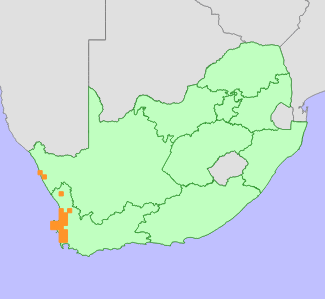|
Scientific Name | Argyrolobium velutinum Eckl. & Zeyh. |
Higher Classification | Dicotyledons |
Family | FABACEAE |
National Status |
Status and Criteria | Vulnerable A2c |
Assessment Date | 2016/02/11 |
Assessor(s) | N.A. Helme, T.J. Edwards, D. Raimondo & L. von Staden |
Justification | A widespread (EOO 29 500 km²) and still fairly common species that has declined by at least 30% over the past 150 years (three generations) due to ongoing, severe destruction of lowland sandplain fynbos in the southern parts of its range. |
Distribution |
Endemism | South African endemic |
Provincial distribution | Northern Cape, Western Cape |
Range | Namaqualand to the Cape Flats. |
Habitat and Ecology |
Major system | Terrestrial |
Major habitats | Namaqualand Coastal Duneveld, Namaqualand Strandveld, Cape Flats Dune Strandveld, Langebaan Dune Strandveld, Saldanha Limestone Strandveld, Saldanha Flats Strandveld, Saldanha Granite Strandveld, Lambert's Bay Strandveld, Graafwater Sandstone Fynbos, Cape Flats Sand Fynbos, Atlantis Sand Fynbos, Hopefield Sand Fynbos, Leipoldtville Sand Fynbos, Namaqualand Sand Fynbos |
Description | Sandveld and sandveld-strandveld ecotones, alkaline coastal sands. |
Threats |
| At least 45% of this species' lowland sandplain habitat in the southern parts of its range is already irreversibly modified. It has lost habitat to urban expansion on the Cape Flats, and continues to decline to the north of the City of Cape Town due to ongoing urban and industrial development. It is also threatened by ongoing habitat loss to urban expansion and coastal development on the Vredenburg Peninsula. Most of this species' remaining habitat on the Cape West Coast between Langebaan, Mamre and Milnerton is also densely infested with alien invasive plants, which are outcompeting native species. In the Sandveld region between Graafwater and Aurora there is rapid, ongoing habitat loss to expanding potato and rooibos tea cultivation. Further north in Namaqualand, some subpopulations are potentially threatened by habitat loss to open-cast mining of coastal dunes. |
Population |
This species continues to decline due to ongoing habitat loss in the southern parts of its range, where it is now locally extinct on the Cape Flats. Recent field observations have found it to be still relatively common on the Vredenburg Peninsula, but it is becoming increasingly rare in sandveld around Malmesbury, Hopefield and the area between Graafwater and Aurora. Recent field observations have also extended the known range to coastal sands in Namaqualand, where it is known from a few, scattered records, but may also be overlooked. This species is a long-lived resprouter (generation length estimated as at least 50 years), and a population reduction of at least 30% is inferred from at least 45% habitat loss over the past three generations (150 years).
|
Population trend | Decreasing |
Assessment History |
Taxon assessed |
Status and Criteria |
Citation/Red List version | | Argyrolobium velutinum Eckl. & Zeyh. | VU A2c | 2017.1 | | Argyrolobium velutinum Eckl. & Zeyh. | EN B1ab(i,iii,iv,v) | Raimondo et al. (2009) | |
Bibliography |
Edwards, T.J. 2005. A synopsis of Argyrolobium (tribe Genisteae, Papilionoideae) in South Africa. South African Journal of Botany 71(3):380-417.
Manning, J.C. and Goldblatt, P. 2012. Plants of the Greater Cape Floristic Region 1: The Core Cape Flora. Strelitzia 29. South African National Biodiversity Institute, Pretoria.
Raimondo, D., von Staden, L., Foden, W., Victor, J.E., Helme, N.A., Turner, R.C., Kamundi, D.A. and Manyama, P.A. 2009. Red List of South African Plants. Strelitzia 25. South African National Biodiversity Institute, Pretoria.
|
Citation |
| Helme, N.A., Edwards, T.J., Raimondo, D. & von Staden, L. 2016. Argyrolobium velutinum Eckl. & Zeyh. National Assessment: Red List of South African Plants version 2024.1. Accessed on 2025/10/26 |
 Comment on this assessment
Comment on this assessment


